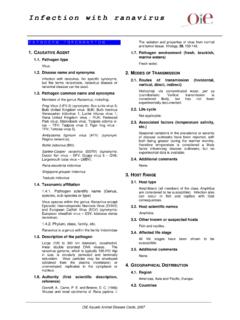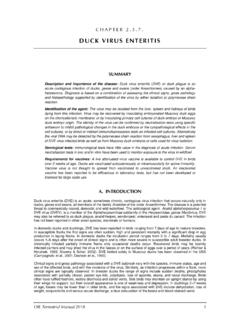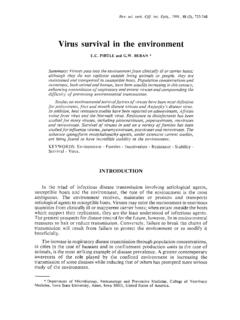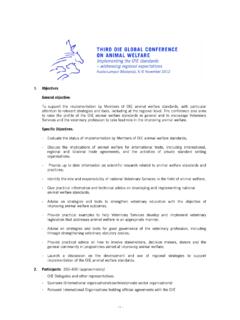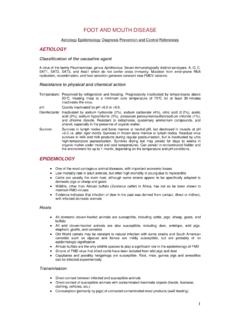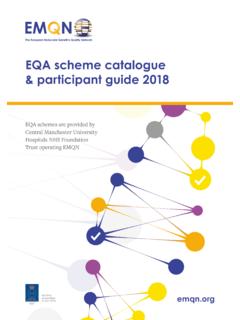Transcription of GUIDELINES FOR INVESTIGATION OF SUSPICIOUS …
1 GUIDELINES FOR INVESTIGATION . OF SUSPICIOUS BIOLOGICAL EVENTS. ( GUIDELINES for national veterinary services). MARCH 2018. INTRODUCTION. The World Organisation for Animal Health (OIE). has developed these GUIDELINES for the INVESTIGATION of SUSPICIOUS biological events with the goal of strengthening the capacity of veterinary Services in Member Countries. In response to the changing landscape of biological threats and the perceived likelihood of criminal or terrorist acts involving pathogens or toxins, guidance for prevention, preparedness and response so such USAIDAsia-RichardNyberg attacks was issued by many countries, organisations and institutions. However, most of this guidance focuses on laboratory settings and protection of human health, leaving a gap regarding general guidance for veterinary Service. To address this gap, the OIE developed these GUIDELINES which should be understood as impulse rapid response and effective communications.
2 In case of a on how to identify biological events that warrant deliberately caused outbreak this includes the identification of further INVESTIGATION and on good practices for (joint) the perpetrator(s), attribution and prosecution, to serve justice investigations of such events. but also to prevent further criminal acts involving pathogens or biological toxins. SCOPE. The OIE supports an all-hazards approach to the BOX 2. management of natural, accidental or deliberate biological INTERNATIONAL INSTRUMENTS FOR. incidents (ranging from small-scale criminal acts to large- BIOLOGICAL THREAT MITIGATION. scale acts of bioterrorism). These GUIDELINES have been specifically developed to aid veterinary Services to prepare for BIOLOGICAL AND TOXINS INTERNATIONAL HEALTH. the INVESTIGATION of SUSPICIOUS biological events in relation to WEAPONS CONVENTION REGULATIONS (IHR): animal health, taking into account the additional challenges (BWC): have the purpose to prevent, related to joint investigations.
3 Prohibits the States Parties to the protect against, control and Convention to develop, produce provide a public health response These GUIDELINES are not prescriptive; they provide or stockpile biological or toxin to the international spread of a compilation of relevant issues that should be considered weapons. disease ( , IHR). in planning for the response to SUSPICIOUS disease events. In addition, these GUIDELINES call for intersectoral and interregional UNITED NATIONS PERFORMANCE OF. cooperation in relation to INVESTIGATION and management of SECURITY COUNCIL veterinary SERVICES. such events. Intersectoral relationships need to be developed RESOLUTION 1540 PATHWAY (PVS): (UNSCR 1540): is a global programme for the and strengthened in advance of an event in order to agree addresses the non-proliferation sustainable improvement of a on and implement effective and efficient response strategies of chemical, biological, country's veterinary Services'.
4 (Box 1 and Box 2). radiological and nuclear compliance with OIE standards Containment and elimination of the threat to protect human weapons with focus on non-state on the quality of veterinary and animal health, the environment, economic viability and actors. Services trade in a One Health approach will require early detection, BOX 1. BIOLOGICAL THREAT prevent their loss, misuse, unauthorised (or biothreat) refers to the accidental or access, or intentional unauthorised release. DEFINITIONS. deliberate release of a pathogen or toxin into Additional definitions are provided a susceptible population. LABORATORY BIOSAFETY. as hyperlinks in the electronic version of describes the principles and practices for LABORATORY BIOSECURITY the prevention of unintentional exposure these GUIDELINES . describes the controls on biological to biological materials, or their accidental materials within laboratories, in order to release.
5 2. ORGANISATIONAL GUIDELINES . 1. LEGISLATION, LAW, REGULATIONS AND POLICY additional sample collection and testing, INVESTIGATION , The National veterinary Services should have the legal reporting and security. authority to lead or support INVESTIGATION and response in suspected or confirmed biological incidents related to animal 4. FACILITIES. health. Legislation for these biological threat events should veterinary Services should build into outbreak be harmonised with existing or proposed national legislation contingency response plans the provision for access to a including identification of a lead agency, communications range of facilities. These may be shared with law enforcement lines and coordination of responsibilities. Where veterinary and other agencies, and include secure communications Services lack appropriate legislation, regulations and and IT networks, crisis management centres (that may policies to address biothreats countries should identify this be co-located with other operational agencies), additional as a priority area for development and work with national laboratory diagnostics and sample storage spaces.
6 Authorities to address these gaps. 5. RESOURCES. 2. ORGANISATIONAL STRUCTURE AND LEADERSHIP veterinary Services should be resourced to maintain day- The Chief veterinary Office (CVO) or other Competent to-day operations as well to having contingency funding to Authority should take the veterinary Services lead in the support the additional costs associated with responding biothreat domain and place it on the national agenda. to a biothreat event. These additional costs may include veterinary Services should appoint a position, held by an additional laboratory sampling and testing, sample storage, individual or a group, who is responsible for dealing with over time pay associated with the INVESTIGATION , enhanced biothreats. This person or persons may be a nominated personal protective equipment, surge personnel, and other OIE Focal Point, or other similar position.
7 Awareness and response requirements. management of biothreats requires interaction with and involvement of veterinary Services stakeholders, including 6. PARTNERSHIP: STAKEHOLDERS, PARTNERS, PUBLIC. the government (law enforcement and others), private veterinary Services stakeholder and partnership sectors, laboratories, livestock and producer groups, animal relationships in biothreat events may include, for example: owners, as well as the general public. a. National agencies and ministries including health, law enforcement, interior, border and customs, 3. PERSONNEL CAPACITY AND CAPABILITIES environment, trade/commerce, foreign affairs, OIE's Performance of veterinary Services*(PVS) and defence, finance, crisis management, civil protection World Health Organization's (WHO) Joint External Evaluation and agriculture or rural affairs. (JEE) are important tools, amongst others, that countries b.
8 Industry including producers, transport, processing, can use to identify gaps in personnel capacity and capability distributors and retail. for response to outbreaks of disease, including biothreats. c. Intergovernmental organisations including the OIE. It is important to understand that additional personnel may Network, INTERPOL, UN Bodies or Agencies, such be required at operational, field, and laboratory levels when as WHO, Food and Agriculture Organisation (FAO), responding to events that are suspected or proven to be United Nations Office for Disarmament Affairs intentional. These include, but are not limited to, capability (UNODA), United Nations Office of Counter-Terrorism to deal with inter-agency engagement and communication, (UNOCT) and United Nations Office for Disaster Risk Reduction (UNISDR). AngelBattleBros233/365. d. Non-governmental organisations.
9 E. Bordering countries and regional partners. f. General public through appropriate communication strategies. Stakeholder documents that regulate cooperation on different levels should be reviewed or developed to meet the requirements of the response to a biothreat event. These could include Partnership Memorandum of Understanding (MOU), Memorandum of Agreement (MOA), Standard Operating Procedures (SOP), and Mutual Support Agreements (MSA). 3. OPERATIONAL GUIDELINES 2. INCIDENT ASSESSMENT. veterinary Services in conjunction with law enforcement 1. PLANNING (PRE-EVENT) will assist in the joint assessment of biothreat events with veterinary Service should pre-plan, train and exercise evaluation of potential intentional activities (Fig. 2). Examples capabilities in preparation for a biothreat event. A capability for triggers or indicators are given in Box 4.
10 Assessment should be conducted to identify current gaps in capability and capacity related to biothreat events, using OIE Performance of veterinary Services Pathway (PVS), Joint External Evaluation (JEE) and other appropriate assessment veterinary Services tools. Contingency planning should include meeting surge requirements including laboratory requirements that may not be nationally available. Pre-planning should include coordination with intersectoral partners and stakeholders (Box 3 and Fig. 1). BOX 3. Industry Biothreat Law veterinary SERVICES PLANNING producers enforcement event Identify and appoint a veterinary Services lead/focal point for biothreat events Identify and coordinate with local, state and national agencies involved in biothreat events and identify roles and responsibilities Other Identify and coordinate with stakeholders and partners: government - Develop protocols for joint response agencies - Develop reporting requirements and protocols - Plan for biothreat response lead investigations and handover procedures Fig.

